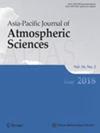Classification and Key Factors for the Snowfall over the Eastern Part of the Korean Peninsula
Abstract
Typical snowfall structure over the coastal mountainous region of the Korean Peninsula is investigated. East coast-type snowfall (ET) due to the lake-effect over the East Sea of Korea is dominant for snowfall intensity and duration. The ET can be divided by the high-pressure system over the Gaema Plateau (GH) and the extratropical low-pressure system passing southern part of the Korean Peninsula in addition to the GH pattern (GHSL). Composite analysis showed that the GHSL can allow a greater inflow of the snowfall from the sea into the land than the GH. The key factors for snowfall structure are 1) the wind-turning layer (WTL), which is the transition level from the lower-level easterly to the upper-level westerly; 2) vertical wind shear suppressing updrafts near the WTL and 3) the Froude number (Fr), which determines the snowfall penetration beyond the mountain. A higher WTL height indicates a deeper easterly layer, indicating favorable conditions for inland snowfall penetration. The strong vertical wind shear plays a role of suppressed updrafts near the WTL via downward momentum transport. It is presented that updraft limitation is mostly exerted by the wind shear. Fr indicates whether the weather system is blocked or unblocked by the mountains. It is shown that the larger Fr generally increases with height, which means that snow systems or flows near the mountain tops can easily to overcome the topography. It is shown that both dynamic and thermodynamic factors are important for understanding and predicting the structure and regions of snowfall.

 求助内容:
求助内容: 应助结果提醒方式:
应助结果提醒方式:


